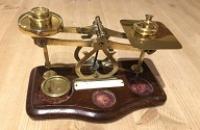




Children often enjoy filling cartons that are suspended in elastic (informal spring scale) to see how far they go down with different items.
Adults could cut cartons in half, punch a hole in each side and thread with string, suspending them on thin elastic bands taped to a wall/cupboard. A selection of small everyday items of different weights can provide surprises.
The Activity
Children choose items to put into the cartons and discuss why some items pull the carton down further than others. They can then predict for new items.
Encouraging mathematical thinking and reasoning:
Describing
What do you see? What are you noticing?
What happened with the orange? Did it go down a lot further or a little further compared with the ...?
Reasoning
What do you think is happening this time?
I wonder why we are getting different things happening?
Why do you think that? What about you, Jordan?
Opening Out
I wonder what will happen with the sponge and the pebble? And the banana?
What do you think?
How sure are you?
Why do you think our prediction was wrong? What about you?
Recording
Can you make a mark where you think the bottom of the carton will stretch to?
What do the marks tell us? What happened?
Maybe use a different colour for your guess and what really happened.
Which is your guess and which is Amir's?
The Mathematical Journey
Measures:
- using language - lower than, higher than, half-way, not/nearly as far as, further than, heavier/lighter than, a little/a lot heavier, nearly as heavy as, heaviest/lightest, exactly the same weight as, equal to
- comparing weights of two objects
- ordering weights of several objects
- explaining - "The orange is heavier because it went down further" and "The one that did not go down as far is lighter"
Development and Variation

Fill the carton using different things: some larger and lighter (e.g. a sponge), and some smaller and heavier (e.g. a stone).
Go 'big' and outdoors: suspend a hanging basket from a bracket with a bungee spring.
See what happens with traditional spring scales or digital luggage scales.
Resources
Cartons for fruit juice, milk or soup, string, hole punch, long thin elastic bands and tape.
A collection of fruit, vegetables, toys and everyday objects of different mass, some lighter (e.g. sponge, pumice stone, shells, plastic toys, pine cones) and some heavier (e.g. pebbles, a bunch of keys, oranges).
Paper on the wall or a board, different coloured pens.
See this clip of Helen Williams talking with a group of ITT students about spring scales: https://www.youtube.com/watch?v=YUDzLOVPZM8
Download a PDF of this resource.

